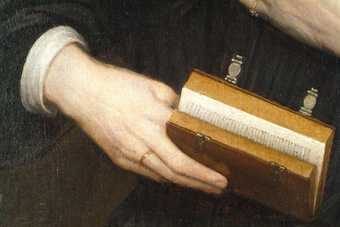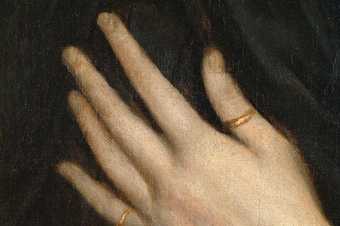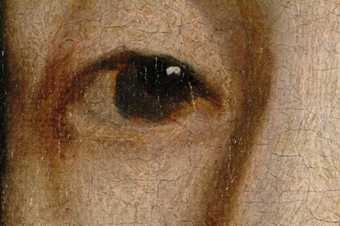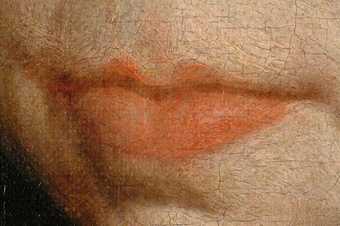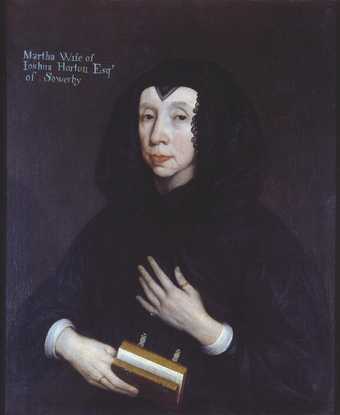
Fig.1
British School 17th century
A Lady of the Horton Family c.1665
Oil paint on canvas
749 x 622 mm
N02878
This painting is in oil paint on canvas, measuring 749 x 622 mm (fig.1). The canvas is a single piece of plain woven linen made up of 15 x 15 threads per square centimetre. There are many slubs in the threads. Cusping of the canvas weave is present along the top edge of the canvas (fig.2).1 The original tacking margins no longer exist. The four-bar stretcher dates from 1969, when the canvas was lined at Tate. This lining replaced an older, in which the adhesive was glue-composition.

Fig.2
X-radiograph of A Lady of the Horton Family
The ground is red and is on average 80 microns thick. It is composed of red ochres, raw sienna, lead white and Cologne earth, all bound together in oil.2 The ground is covered over with an oil-bound white priming, on average 35 microns thick and made of lead white and a little Cologne earth (fig.3). Abrasion of the painting during early, harsh cleanings has worn through the paint and priming to reveal the red ground in many dark areas.
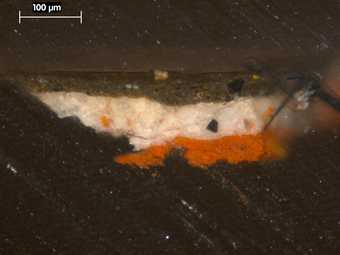
Fig.3
Cross-section from the background, photographed at x250 magnification. From the bottom: red ground; white priming; dark green paint; varnish
The technique of the painting is fairly simple. Both the dark background paint and that for the black costume were applied directly to the white priming with no discernible underpainting. No linear underdrawing is evident either; the outlines of the figure appear to have been brushed in with opaque beige coloured paint, which is visible at the edges of the hands at high magnification but which is not detectable with infra-red or x-ray on account of the underlying red ground. There are minor pentimenti in the positioning of the hood, the forefinger of the proper right hand and the top left clasp of the book (figs.4−6). The face appears to have been delineated first with thin reddish brown paint applied with a brush (figs.6−10). These tones were left visible to form the shadows around the features.
Thereafter the face was built-up wet-in-wet with tones made up of granular lead white, a glassy blue pigment, red lake, an opaque bright red, large cubic yellow particles and carbon black. In both eyes the white of the eyeball and the catch-light on the pupil have blue pigment mixed with white lead (figs.11 and 12).

Fig.11
Detail of blue pigment in the white of the eye

Fig.12
Detail of blue pigment in the catch-light of the pupil
The black tones of the costume were mixed from bone black and lead white and applied wet-in-wet to the primed canvas. The paint of the light blue inscription, put on when the background paint was dry, contains lead white and ultramarine (fig.13).
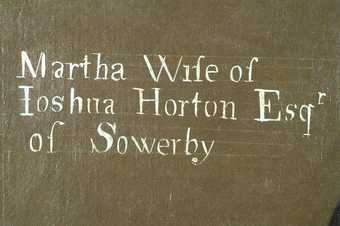
Fig.13
The inscription
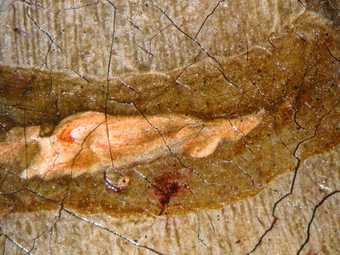
Fig.14
Micrograph showing the paint to create the sparkle on the thumb ring
The rings on the sitter’s hands were painted in different ways. The thumb ring was applied by dragging wet paint though wet flesh paint with a dot of opaque pink to create the sparkle (fig.14). The small finger ring on the same hand was applied in a similar way but the flesh paint was clearly much dryer and did not indent to the same extent. The ring on the hand holding the book was applied over the flesh paint when it was touch dry; there is no sense of disruption of the underlying layer.
The painting was cleaned and restored at Tate in 1969. The lining mentioned above is canvas with wax-resin adhesive.
August 2003


